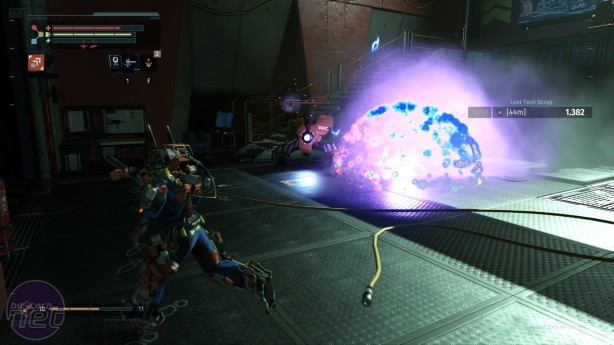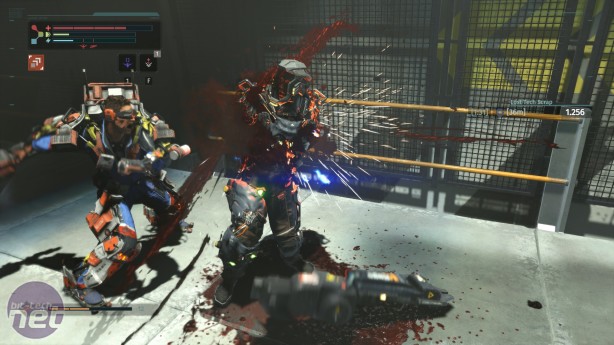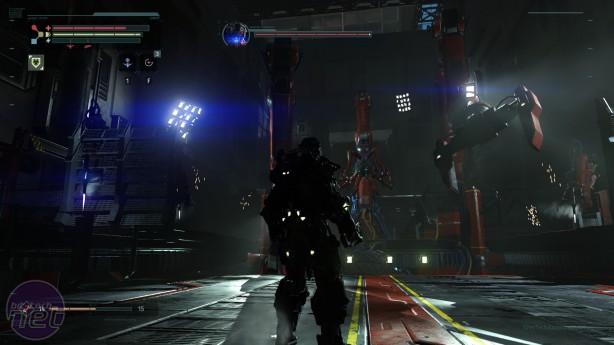
So far, so similar. But The Surge adds a couple of new elements to the combat. Foremost amongst these is its limb-targeting system. Enemies tend to be heavily armoured, but usually have at least one limb exposed. Attacking this appendage will do considerably more damage than directing blows at armour. What’s more, if you build up your attack meter sufficiently, you’ll be able to perform a grisly execution which cuts the limb off entirely.
Alone, this doesn’t add much to the combat. But Deck 13 has cleverly tied this system into acquiring new weapons and armour. Although you’ll pick up the odd spear or helmet through exploration, your main source of equipment is from your opponents. To acquire new gear from an enemy, you must target the specific limb it’s attached to, and physically separate that limb from its owner.
Cutting an armoured limb is considerably more difficult than cutting an unarmoured limb, and consequently this adds a pleasing risk/reward element to the basic combat. Do you focus on weak-points and give yourself a better chance of reaching the next shortcut, or do you concentrate on collecting a new armour set before tracking down the next boss? The Surge further encourages you to be bold by multiplying the amount of tech-scrap you gain for each fight you win. But of course, if you die, you only get one shot at retrieving that scrap before you lose it entirely.
As a straightforward melee combat game, The Surge is thoroughly enjoyable. The combat is slick, fast-paced, and precise in terms of tracking hits, weapon-reach, and dodges. It doesn’t contain the variety of opponents seen in From Software’s games, but there are some wonderful designs in there. One I particularly enjoyed fighting is a welding robot with a heavily armoured front but a vulnerable rear. Alongside attacking with deceptive swings of its welding-arm, it can also pull you towards it with a beautifully animated tractor beam and project a hemispherical force-field which slows you down if you enter it.
Bosses, too, are spectacular encounters. Each boss fight usually has multiple stages to it. and they all play on The Surge’s theme of robots and heavy industry. My favourite was probably Big Sister, essentially a giant conveyor belt designed to vaguely resemble a spider. Its first stage sees you avoiding two huge and powerful grabbing arms, while the second stage has you weaving between four smaller yet faster welding arms. It’s a genuinely brilliant encounter, challenging, inventive, and stunningly animated.
Where The Surge struggles compared to Dark Souls is in the grander scope of and finer details of its adventure. In the transition from decaying fantasy land to near-future factory floor, some of the magic has been lost. I like the setting in theory, the surroundings of colossal industry and decrepit technology are a fine fit for a Souls-like. But the execution is a bit bland. You spend a lot of time running through various types of dingy corridors, along metal gantries, inside sewer pipes, through shadowy research labs. On the rare occasions you step outside, the dusty landscape and nondescript piles of scrap don’t hold the same fascination as From’s haunted world and extravagant gothic architecture. The levels themselves are well designed, with lots of secrets and shortcuts that gradually unfold as you explore. But it wasn’t weird or interesting enough to hold my attention beyond smacking robots about with a big metal pole.
What doesn’t help is that the writing is terrible. Every character you encounter spits out a mouthful of sarcastic one-liners that are tonally inconsistent with their desperate situation. Imagine the worst example of a Steven Moffat script, where it’s all wit and no depth, except the jokes fall flat as well. The Surge also takes a stab at being cryptic and mysterious, but instead of offering you intriguing tidbits of information, the survivors of the CREO catastrophe are simply clueless about what’s going on. It even becomes a running joke within the game, and it’s never good when a developer begins to make jokes about a flaw in its own design.
You might think it unfair to compare The Surge to Dark Souls, but Deck 13 imitates the structure of From Software’s game so closely that it would be silly to ignore it. It’s plain to see where that mimicry works and where it doesn’t. The good news is, I think, overall the Surge succeeds more than it fails. Although the world and the story never gripped me, the combat certainly did, especially the boss fights. The Surge may not be a classic, but it’s worth a punt if you’ve exhausted From’s catalogue of punishment and are masochistic enough to want more.
Alone, this doesn’t add much to the combat. But Deck 13 has cleverly tied this system into acquiring new weapons and armour. Although you’ll pick up the odd spear or helmet through exploration, your main source of equipment is from your opponents. To acquire new gear from an enemy, you must target the specific limb it’s attached to, and physically separate that limb from its owner.
Cutting an armoured limb is considerably more difficult than cutting an unarmoured limb, and consequently this adds a pleasing risk/reward element to the basic combat. Do you focus on weak-points and give yourself a better chance of reaching the next shortcut, or do you concentrate on collecting a new armour set before tracking down the next boss? The Surge further encourages you to be bold by multiplying the amount of tech-scrap you gain for each fight you win. But of course, if you die, you only get one shot at retrieving that scrap before you lose it entirely.
As a straightforward melee combat game, The Surge is thoroughly enjoyable. The combat is slick, fast-paced, and precise in terms of tracking hits, weapon-reach, and dodges. It doesn’t contain the variety of opponents seen in From Software’s games, but there are some wonderful designs in there. One I particularly enjoyed fighting is a welding robot with a heavily armoured front but a vulnerable rear. Alongside attacking with deceptive swings of its welding-arm, it can also pull you towards it with a beautifully animated tractor beam and project a hemispherical force-field which slows you down if you enter it.
Bosses, too, are spectacular encounters. Each boss fight usually has multiple stages to it. and they all play on The Surge’s theme of robots and heavy industry. My favourite was probably Big Sister, essentially a giant conveyor belt designed to vaguely resemble a spider. Its first stage sees you avoiding two huge and powerful grabbing arms, while the second stage has you weaving between four smaller yet faster welding arms. It’s a genuinely brilliant encounter, challenging, inventive, and stunningly animated.
Where The Surge struggles compared to Dark Souls is in the grander scope of and finer details of its adventure. In the transition from decaying fantasy land to near-future factory floor, some of the magic has been lost. I like the setting in theory, the surroundings of colossal industry and decrepit technology are a fine fit for a Souls-like. But the execution is a bit bland. You spend a lot of time running through various types of dingy corridors, along metal gantries, inside sewer pipes, through shadowy research labs. On the rare occasions you step outside, the dusty landscape and nondescript piles of scrap don’t hold the same fascination as From’s haunted world and extravagant gothic architecture. The levels themselves are well designed, with lots of secrets and shortcuts that gradually unfold as you explore. But it wasn’t weird or interesting enough to hold my attention beyond smacking robots about with a big metal pole.
What doesn’t help is that the writing is terrible. Every character you encounter spits out a mouthful of sarcastic one-liners that are tonally inconsistent with their desperate situation. Imagine the worst example of a Steven Moffat script, where it’s all wit and no depth, except the jokes fall flat as well. The Surge also takes a stab at being cryptic and mysterious, but instead of offering you intriguing tidbits of information, the survivors of the CREO catastrophe are simply clueless about what’s going on. It even becomes a running joke within the game, and it’s never good when a developer begins to make jokes about a flaw in its own design.
You might think it unfair to compare The Surge to Dark Souls, but Deck 13 imitates the structure of From Software’s game so closely that it would be silly to ignore it. It’s plain to see where that mimicry works and where it doesn’t. The good news is, I think, overall the Surge succeeds more than it fails. Although the world and the story never gripped me, the combat certainly did, especially the boss fights. The Surge may not be a classic, but it’s worth a punt if you’ve exhausted From’s catalogue of punishment and are masochistic enough to want more.


MSI MPG Velox 100R Chassis Review
October 14 2021 | 15:04













Want to comment? Please log in.